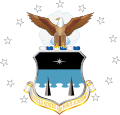
The United States Air Force Academy (USAFA) is a United States service academy in El Paso County, Colorado, immediately north of Colorado Springs. It educates cadets for service in the officer corps of the United States Air Force and United States Space Force. It is the youngest of the five service academies, having graduated its first class 65 years ago in 1959, but is the third in seniority. Graduates of the academy's four-year program receive a Bachelor of Science degree and are commissioned as second lieutenants in the U.S. Air Force or U.S. Space Force. The academy is also one of the largest tourist attractions in Colorado, attracting approximately a million visitors each year.

The Distinguished Flying Cross (DFC) is a military decoration of the United States Armed Forces. The medal was established on July 2, 1926, and is currently awarded to any persons who, after April 6, 1917, distinguish themselves by single acts of heroism or extraordinary achievement while participating in aerial flight. Both heroism and extraordinary achievement are entirely distinctive, involving operations that are not routine. The medal may be awarded to friendly foreign military members in ranks equivalent to the U.S. paygrade of O-6 and below in combat in support operations.

General John Charles Meyer was an American World War II flying ace, and later the commander-in-chief of the Strategic Air Command (SAC) and director of the Joint Strategic Target Planning Staff at Offutt Air Force Base, Nebraska. SAC was the United States' major nuclear deterrent force with bombers, tankers and reconnaissance aircraft, and intercontinental ballistic missiles. The Joint Strategic Target Planning Staff coordinated the nation's nuclear war plans and developed the Single Integrated Operations Plan.

The Air Force Reserve Officers' Training Corps (AFROTC) is one of the three primary commissioning sources for officers in the United States Air Force and United States Space Force, the other two being the United States Air Force Academy (USAFA) and Air Force Officer Training School (OTS). A subordinate command of the Air University within the Air Education and Training Command (AETC), AFROTC is aligned under the Jeanne M. Holm Center for Officer Accessions and Citizen Development at Maxwell AFB, Alabama. The Holm Center, formerly known as the Air Force Officer Accession and Training Schools (AFOATS), retains direct responsibility for both AFROTC and OTS.
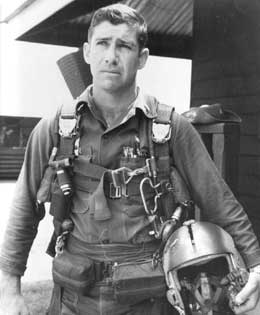
Karl Wendell Richter was an officer in the United States Air Force and an accomplished fighter pilot during the Vietnam War. At the age of 23 he was the youngest pilot in that conflict to shoot down a MiG in air-to-air combat.
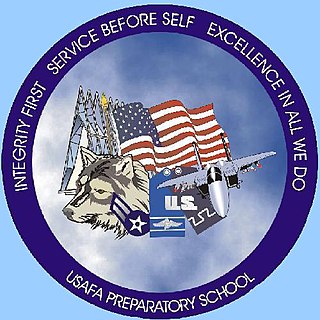
The U.S. Air Force Academy Preparatory School—usually referred to as "the Prep School" or "The P School"—was established in May 1961. The school's founder and first commander was Colonel Lee Charles Black. It is located on the campus of the United States Air Force Academy near the Community Center. The Prep School's mission is to prepare, motivate, and evaluate for admission to and success at the Air Force Academy. Students at the prep school are referred to as "cadet candidates" or more informally as "preppies."

James "Jabby" Jabara was the first American and United States Air Force jet ace. Born in Oklahoma, he lived in Kansas where he enlisted as an aviation cadet at Fort Riley after graduating from high school. Jabara attended four flying schools in Texas before he received his pilot's wings and was commissioned as a second lieutenant. Jabara flew two tours of combat duty in Europe during World War II as a North American P-51 Mustang pilot, and scored 1.5 air victories against German aircraft.

George Andrew Davis Jr. was a highly decorated fighter pilot and flying ace of the United States Army Air Forces in World War II, and later of the United States Air Force during the Korean War. He was killed in action during a combat mission in northwestern Korea, in an area nicknamed "MiG Alley". For his actions during the Korean War, Davis was posthumously awarded the Medal of Honor and promoted from major to lieutenant colonel.
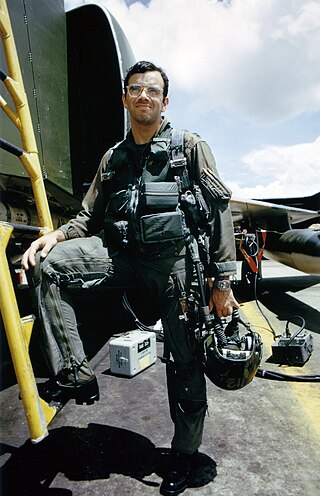
Jeffrey S. Feinstein is a retired career officer of the United States Air Force (USAF). During the Vietnam War, Feinstein was a weapon systems officer, an integral part of two-man aircrews with the emergence of air-to-air missiles as the primary weapons during aerial combat. Flying aboard F-4 Phantom IIs, Feinstein downed five enemy aircraft, thereby becoming a flying ace, the last of five U.S. aviators to become aces during that conflict and to date still the most recent aviator to achieve ace status in the U.S. military.
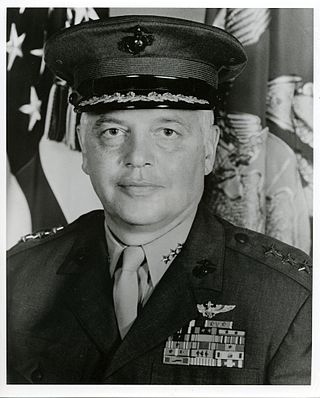
Lieutenant General George C. Axtell was a United States Marine Corps general officer, a World War II flying ace, and a Navy Cross recipient. During World War II, he was the youngest commanding officer of a Marine fighter squadron. He also served in the Korean War and Vietnam War.

The United States Marine Corps is organized within the Department of the Navy, which is led by the Secretary of the Navy (SECNAV). The most senior Marine commissioned officer is the Commandant of the Marine Corps, responsible for organizing, recruiting, training, and equipping the Marine Corps so that it is ready for operation under the command of the unified combatant commanders. The Marine Corps is organized into four principal subdivisions: Headquarters Marine Corps, the Operating Forces, the Supporting Establishment, and the Marine Forces Reserve.

Robin Olds was an American fighter pilot and general officer in the United States Air Force (USAF). He was a "triple ace", with a combined total of 17 victories in World War II and the Vietnam War. He retired in 1973 as a brigadier general, after 30 years of service.

Colonel James Helms Kasler was a senior officer in the United States Air Force and the only person to be awarded the Air Force Cross three times. The Air Force Cross ranks just below the Medal of Honor as an award for extraordinary heroism in combat.

The 98th Flying Training Squadron is a United States Air Force unit assigned to the 306th Flying Training Group. It is stationed at the United States Air Force Academy, Colorado, however its De Havilland Canada UV-18 Twin Otter aircraft are housed and maintained at nearby Peterson Air Force Base, Colorado.
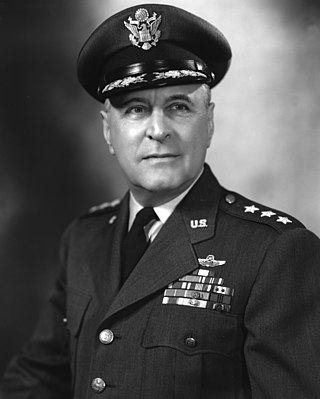
Harold Lee George was an American aviation pioneer who helped shape and promote the concept of daylight precision bombing. An outspoken proponent of the industrial web theory, George taught at the Air Corps Tactical School and influenced a significant group of airmen passing through the school, ones who had powerful influence during and after World War II. He has been described as the leader of the Bomber Mafia, the men who advocated for an independent military arm composed of heavy bombers. George helped shape America's bomber strategy for the war by assisting Air War Plans Division with the development of a complete aircraft production and bombing strategy.
Hispanics in the United States Air Force can trace their tradition of service back to the United States Army Air Forces (USAAF), the military aviation arm of the United States Army during and immediately after World War II. The USAAF was the predecessor of the United States Air Force, which was formed as a separate branch of the military on September 18, 1947, under the National Security Act of 1947. In the U.S., the term Hispanic categorizes any citizen or resident of the United States, of any racial background, of any country, and of any religion, who has at least one ancestor from the people of Spain or is of non-Hispanic origin but has an ancestor from Mexico, Puerto Rico, Cuba, Central or South America, or some other Hispanic origin. The three largest Hispanic groups in the United States are the Mexican-Americans, Puerto Ricans, and Cubans. According to the U.S. Census Bureau the estimated Hispanic population of the United States is over 50 million, or 16% of the U.S. population, and Hispanics are the nation's largest ethnic minority. The 2010 U.S. census estimate of over 50 million Hispanics in the U.S. does not include the 3.9 million residents of Puerto Rico, thereby making the people of Hispanic origin the nation's largest ethnic or race minority as of July 1, 2005.

Dale E. Stovall is a retired Brigadier General in the United States Air Force who figured prominently in several search and rescue operations during the Vietnam War. A member of the 40th Aerospace Rescue and Recovery Squadron based in Thailand, on June 2, 1972, he recovered Capt. Roger Locher from deep inside North Vietnam, the deepest rescue made during the entire Vietnam War. For his efforts in rescuing Locher, Stovall was awarded the Air Force Cross, which described how "he willingly returned to this high threat area, braving intense ground fire, to recover the downed airman from deep in North Vietnam.". Stovall was also recognized with the 1973 Jabara Award for Airmanship, two Silver Star awards and two Distinguished Flying Cross awards for other combat rescues among the 12 successful rescue missions he accomplished during his tour in Southeast Asia. Stovall retired from the Air Force as a brigadier general on June 1, 1993.

The Air Force Academy sometimes shortened as IDAFA, is a service academy of the Indonesian Air Force, the air force component of the Indonesian National Armed Forces Academy System or the AKABRI. Its campus is located in the Adisutjipto Air Force Base complex in Yogyakarta, Special Region of Yogyakarta and trains men and women to become commissioned officers of the Indonesian Air Force. Of all the service academies in Indonesia, despite the AAU having been opened in November 1945, it has roots dating back to 1921.



















